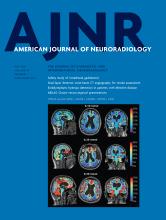This article requires a subscription to view the full text. If you have a subscription you may use the login form below to view the article. Access to this article can also be purchased.
Abstract
SUMMARY: Clinical adoption of an artificial intelligence–enabled imaging tool requires critical appraisal of its life cycle from development to implementation by using a systematic, standardized, and objective approach that can verify both its technical and clinical efficacy. Toward this concerted effort, the ASFNR/ASNR Artificial Intelligence Workshop Technology Working Group is proposing a hierarchal evaluation system based on the quality, type, and amount of scientific evidence that the artificial intelligence–enabled tool can demonstrate for each component of its life cycle. The current proposal is modeled after the levels of evidence in medicine, with the uppermost level of the hierarchy showing the strongest evidence for potential impact on patient care and health care outcomes. The intended goal of establishing an evidence-based evaluation system is to encourage transparency, foster an understanding of the creation of artificial intelligence tools and the artificial intelligence decision-making process, and to report the relevant data on the efficacy of artificial intelligence tools that are developed. The proposed system is an essential step in working toward a more formalized, clinically validated, and regulated framework for the safe and effective deployment of artificial intelligence imaging applications that will be used in clinical practice.
ABBREVIATIONS:
- AI
- artificial intelligence
- HIPPA
- Health Insurance Portability and Accountability Act
- © 2023 by American Journal of Neuroradiology











